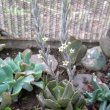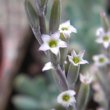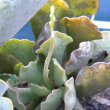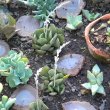Adromischus cristatus
| Botanical Name | Adromischus cristatus |
|||||||||||
| Family | Crassulaceae - The crassula family. |
|||||||||||
| Pronunciation | ad-roh-MIS-kus kris-TAY-tus |
|||||||||||
| Common Name(s) |
USA: Crinkle-Leaf Plant
|
|||||||||||
| Plant Group |
|
|||||||||||
| Plant Size |
|
|||||||||||
| Position |
|
|||||||||||
| General Information |
|
|||||||||||
| Specific Information | Adromischus cristatus is a compact, rather slow-growing, evergreen, succulent with semi-upright branches covered with dense, reddish-brown aerial roots. The slightly triangular or fan-shaped, grey-green leaves are crinkled along the flattened at tips and covered with tiny hairs. The leaves are presented in groups in loose rosettes. Flowers add interest but are not showy. In its natural habitat it i invariable found sheltering from the hottest part of the day beneath the scrubby growth of shrubs or other vegetation. |
|||||||||||
| Ad Break | ||||||||||||
| Flowers | ||||||||||||
| Description | tubular in shape with five flared, pointed, white petals, variously tipped with pink, held on long, narrow stalks |
|||||||||||
| Season |
|
|||||||||||
| Colour |
|
|||||||||||
| Growth Rate |
|
|||||||||||
| Plant Uses |
|
|||||||||||
| Distribution and Habitat | in the Eastern Cape Province, in three independent populations, all in the westernmost part of the province, in the areas of Willowmore, Graaff-Reinett and Jeffrey's Bay |
|||||||||||
| Planting Suggestions | Adromischus cristatus needs a sunny position, warm temperatures, good airflow and well-drained soil or potting mix. Water weekly during the warm growing season from October to February, but check that the soil dries out between waterings. Reduce water during autumn, and in winter water only enough to keep the leaves from shriveling. The plant will tolerate temperatures down to 0ºC but avoid exposure to frost. Propagate from fresh seed, leaf cuttings, semi-hardwood cuttings or division of the root ball. |
|||||||||||
| Lorraine's Garden Notes | It took over 3 months for the flower to develop from the appearance of the initial stem in mid-December to the open flowers at the end of March. |
|||||||||||
| Medicinal Uses | No data found. |
|||||||||||
| Ad Break | ||||||||||||










Comments
Adromischus cristatus, crinkle leaf plant
I have recently purchased one of these plants. It started growing smaller leafs from the center and I thought it was doing well. I gently touched it one day and the outer, larger leafs fell off!! Am I overwatering and possibly rotting the roots? I "soak it" once a week and the weather has been very hot and dry since I purchased it. The soil feels dry to the touch when I water. Any help would be great and also....can it be saved?
Thank you
Wendy
Ailing Adromischus
Hi Wendy
I can see why you are concerned. If a lot of leaves have fallen off for no reason there appears be a problem. Check the base of the leaves which have fallen off - any signs of discolouration or sogginess will indicate rot. If the base of the leaves is healthy, then rotting is unlikely. The next step would be to remove it from the pot and check the roots and base of the plant. There may be a fungal disease on the roots, or even an ant nest among the roots. If the roots are healthy and rotting is not evident, re-plant your succulent. Saving the plant will depend on the level of disease or rot. All rotten parts must be removed and the remains left to dry out in a shady place until any damaged parts have dried out and developed a clean scar. You could also sprinkle some anti-fungal powder over it.
If all appears well my next thought refers to the history of the plant. If the plant was bought from a nursery it is possible that it has received too much water and not enough sun. This results in the leaves becoming very brittle and the lightest touch can dislodge them. If this appears to be the case, you will need to wean it from water over a period of a few weeks to give the cells time to shrink. The reduced cell size will toughen the leaves so that they do not fall off unless actually pulled off.
The worst case scenario is that the entire plant falls apart and you are left with a lot of loose leaves. Do not despair. Let the base of only the healthy leaves - even if they are quite small - dry out thoroughly for a couple of days and just press them slightly into clean, well drained soil. Keep the soil only slightly moist - preferably water with a spray bottle. After a while some of the leaves will shoot roots and in time will develop into new plants. This could take some time so be patient.
My own specimens have been left out in the sun, often without water for 5 or 6 weeks and are tough. A different variety that I bought from a nursery was so turgid that some of the leaves broke of before I even got it home.
I hope the above will give you some ideas and that you are able to return your plant to health. I would suggest you water it less in future, allowing the soil to remain dry for longer periods, perhaps at two week intervals. Also try to ensure that it gets some direct sun for a few hours every day when possible.
Kind regards
Lorraine
Discuss this plant
Share knowledge, ask a question or give an experience.